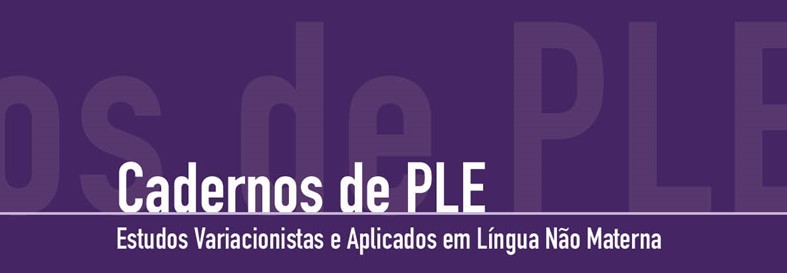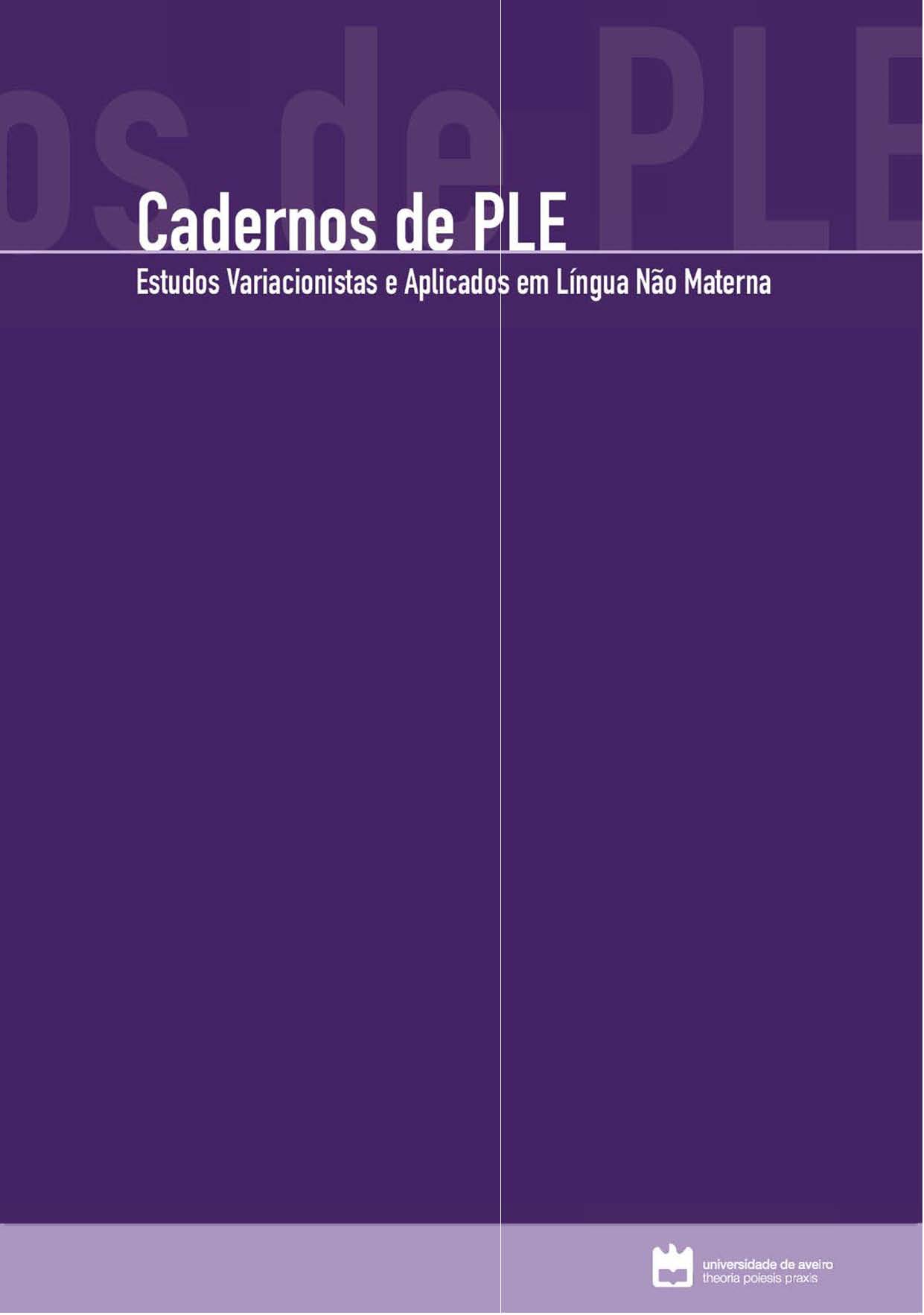Reflexões sobre a aprendizagem da prosódia do português brasileiro como língua estrangeira
Resumo
O objetivo do presente trabalho é trazer uma reflexão sobre o que os aprendizes de Português como Língua Estrangeira (PLE) sabem sobre a Prosódia do Português Brasileiro (PB), de modo que tal conteúdo possa ser abordado em sala de aula. Aprender a prosódia é uma habilidade que permite que os alunos se comuniquem efetivamente com falantes nativos e aprimora sua compreensão cultural. Nossa experiência com alunos falantes de Espanhol e Crioulo Haitiano demonstrou que o conhecimento sobre o PLE pode revelar diferentes níveis de dificuldade a depender da língua materna. As observações tratadas neste artigo estão relacionadas aos aspectos suprassegmentais da pronúncia. A partir de descrições prosódicas feitas para o PB (Rameh, 1966, Moraes, 1993, Fonágy, 1993), foi possível observar que tanto o acento lexical, quanto o acento frasal devem ser objeto de abordagem na sala de PLE, de modo que os aprendizes possam se expressar de forma a manterem a face positiva na interação verbal. Por fim, buscamos sintetizar nossas impressões dos momentos de conversação com alunos iniciantes na aprendizagem do PB,
variante de Minas Gerais, identificando os principais traços de dificuldades prosódicas por eles apresentadas nesse processo.
Referências
Akeberg, M. (2011). Aquisição da pronúncia: a entoação em afirmações e perguntas do tipo sim/não em português e espanhol. Trabalhos em Linguística Aplicada, 50 (1), 155-170. http://www.scielo.br/scielo.php?script=sci_arttext&pid=S0103-18132011000100009&lng=en&nrm=iso
Antunes, L., Aubergé, V. (2015). Análise prosódica da certeza e da incerteza em fala espontânea e atuada. Diadorim, 17 (2), 212-237. https://doi.org/10.35520/diadorim.2015.v17n2a4077
Austin, J. L. (1990). Quando dizer é fazer: palavras e ação. Porto Alegre: Artes Médicas.
Brazil, D.; Coulthard, M. & Johns, C. (1980). Discourse intonation and language teaching. Londres: Longman.
Bodolay, A. (2020) Prática de ensino de Português como língua estrangeira: abordagem pragmática no ensino de prosódia. Revista (Con)Textos Linguísticos. 14 (29), 603-622. https://doi.org/10.47456/cl.v14i29.32139
Bodolay, A., & Forte, G. (2023). Não confunda prosódia com pronúncia: fundamentos de prosódia para PLE. Curitiba: CRV.
Cagliari, L. C. (1992). Da importância da prosódia na descrição de fatos gramaticais. Gramática do português falado, 2, 39-64.
Cruttenden, A. (1997). Intonation. Cambridge: Cambridge University Press.
Fonágy, I. (1993). As funções modais da entonação. Cadernos de Estudos Lingüísticos, 25, 25-65.
Fonágy, I. (2003). Des fonction de l’intonation: essay de synthese. Flambeau, 29, 1- 20
Frota, S., &Vigário, M. (2000). Aspectos de prosódia comparada: ritmo e entoação no PE e no PB. In R. V. Castro & P. Barbosa (Orgs.), Actas do XV Encontro da Associação Portuguesa de Linguística (pp. 533- 555). Braga: Associação Portuguesa de Linguística.
Halliday, M. A. K. (1970). A course in spoken english: Intonation. Oxford: Oxoford University Press.
Hirst, D. & Di Cristo, A. (1998). Intonation Systems: a Survey of Twenty Languages. Cambridge: Cambridge University Press.
Ladd, D. R. (2008). Intonational phonology. Cambridge: Cambridge University Press
Mattoso-Câmara, J. (1953). Para o estudo da fonêmica portuguesa. Rio de Janeiro: Organizações Simões.
Mattoso-Câmara, J. (1970). Estrutura da Língua Portuguesa. São Paulo: Vozes.
Melo, M. C. (2017). Ensino da prosódia nos atos diretivos de ordem e pedido para falantes estrangeiros aprendizes do português brasileiro: uma análise de materiais didáticos. [Dissertação de Mestrado]. UFVJM, Diamantina, Minas Gerais, Brasil.
Melo, M. & Bodolay, A. (2021). O espaço da prosódia em materiais didáticos de PLE. In Meniconi, F., Makiyama , S., Pitombeira, C. Estudos linguísticos aplicados : interlocuções na contemporaneidade (pp. 98-117). Tutóia, MA: Diálogos.
Mendes, R. (2013). A entonação no processo de ensino-aprendizagem de PLE: proposta didática para o ensino de modelos de entonação interrogativa do Português do Brasil – Estado de São Paulo [Apresentação de trabalho/Comunicação]. Universidade de Brasília. http://repositorio.unb.br/handle/10482/14347
Mira-Mateus, M. H., Brito, A. M., Duarte, I., Faria, I. H., Frota, S., Matos, G., Vigário, M., & Villalva, A. (2003). Gramática da Língua Portuguesa. Lisboa: Caminho.
Moraes, J. A. (1986). Acentuação Lexical e Acentuação Frasal em Português: um estudo acústico-perceptivo. II Encontro Nacional de Fonética e Fonologia. UNB.
Moraes, J. A. (1987). Corrélats acoustiques de l'accent de mot en Portugais Brésilien. Proceedings of the XIth International Congress of Phonetic Sciences, 3, 313- 317.
Moraes, J. A (1993). Entoação Modal Brasileira: Fonética e Fonologia. Cadernos de Estudos Linguísticos, 25, 101-111.
Moraes, J. A. (2011). From a prosodic point of view: remarks on attitudinal meaning. In H Mello, A Panunzi, T Raso. (Eds), Pragmatics and Prosody. Illocution, Modality, Attitude, Information Patterning and Speech Annotation. Florença: Firenze University Press.
Pienemann, M. (1985). Learnability and syllabus construction. In Hyltenstam, K. &
Pienemann, M. (Eds.), Modelling and assessing second language acquisition (pp.23-75). Bristol: Multilingual Matters.
Pierrehumbert, J. (1980). The Phonology and phonetics of english intonation. Bloomington: Indiana University Linguistics Club.
Pike, K. (1945). The intonation of American English. Ann Arbor: University of Michigan Publications.
Pinto, J. (2020). O ensino de línguas baseado em tarefas no ensino/aprendizagem da escrita em português língua segunda – propostas didáticas. Revista do GEL, 17( 2), 170-195.
Quadros, R. (2017). Língua de Herança: Língua Brasileira de Sinais. Porto Alegre: Penso Editora.
Rameh, C. (1962). Contrastive analysis of English and Portuguese intonation. Washington, D.C. :Georgetown University.
Rameh, C. (1966). A intonação do Português do Brasil. Estudos Linguísticos, 1, 25-32.
Rameh, C. (1981). Aspectos a língua portuguesa nos Estados Unidos da América do Norte. In Bichakjian, B. (Ed.), From Linguistics to Literature: Romance Studies Offered to Francis M. Rogers. Amesterdão: John Benjamins Publishing.
Reis, C. (1995). L’interaction entre l’accent, l’intonation et le rythme en portugais brésilien. Angola [Tese de Doutoramento]. Marselha: Université de Provence.
Reis, C. (2001). A entonação no ato de fala. In Mendes, E.; Oliveira, P.; Bennibler, V. (Orgs.), O novo milênio: interfaces linguísticas e literárias (pp. 221-229). Belo Horizonte: Fale/UFMG.
Searle, J. (1981). Os actos de fala: um ensaio de filosofia da linguagem. Coimbra: Livraria Almedina.
Staub, A. (1973). A acentuação do inglês e do português: algumas observações construtivas. Letras de Hoje , 2, 35-52.
Wichmann, A. (2000). The attitudinal effects of prosody, and how they relate to emotion. In R. Cowie, E. Douglas-Cowie, M. Schroeder (Eds.). Speech and Emotion: Proceedings of the International Speech Communication Association Research Workshop. (pp.143-148). Belfast: International Speech Communication Association. https://pdfs.semanticscholar.org/a627/2101b42d3e2481427227c2393f2aadaf75bb.pdf
Direitos de Autor (c) 2024 Adriana Nascimento Bodolay

Este trabalho está licenciado com uma Licença Creative Commons - Atribuição 4.0 Internacional.


